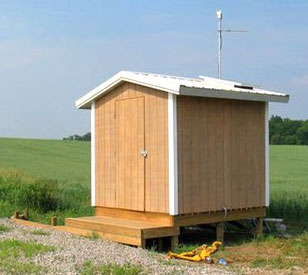Soil Moisture Profiling

Plant growth is dependent on the availability of water in soil, and soil moisture may be of interest in many other commercial and research applications. Soil moisture profiling systems can provide valuable data for vineyards, irrigated and dryland cropping, green roofs, landscape managers, environmental and wetland research, mining, groundwater studies and archaeological sites.
Soil Moisture

Typical Soil Moisture Profiling System
Getting the maximum benefit out of soil moisture monitoring usually requires measurement at various locations and depths. Whether it be crop irrigation, groundwater research or any other application, networks of sensors and soil moisture profiling probes can provide comprehensive data.
NexSens soil moisture profiling systems typically consist of an access tube containing sensors like the Sentek Drill & Drop that measure moisture through capacitance at various depths in the soil profile. This may be just a few sensors near the surface or probes over a meter in length, and custom configurations may go even deeper.
The NexSens X3 data logger records data from moisture sensors and transmits in near real-time to the WQData LIVE web datacenter via 4G LTE cellular or satellite telemetry, where historical trends can be viewed and alarms configured to send email or SMS text message notifications when soil conditions exceed critical thresholds. Systems can operate continuously thanks to SP-series solar power packs.
Other sensors that may be integrated into soil moisture monitoring systems include the Stevens HydraProbe for spot measurement of soil moisture and conductivity, tipping bucket rain gauges, solar radiation sensors and more. The X3 supports a wide-range of standard sensor types and communication protocols.
Contact a NexSens Applications Engineer today to discuss your soil moisture monitoring application.

Case Studies
Wetland Mitigation Bank
The Great Miami Wetland Mitigation Bank is the only such bank in Ohio offering stream restoration credits. It offers credits for corporations and others who want to offset the wetlands they destroy through construction by buying newly restored wetland space. But alongside that mission is another that is mapping the transport of gases as restored wetlands take shape. It is looking at the big question of whether or not newly restored wetlands are sources of greenhouse gases or sinks for them. The University of Nebraska-Lincoln, with funding from NASA, is heading up the work. Scientists with the school instrumented the mitigation bank with a number of monitoring stations to chart changes that a newly restored wetland undergoes.
Read MoreWatershed Monitoring
In order to improve water quality and protect drinking water, researchers at the St. Joseph River Watershed in Indiana are working to identify best management practices that will reduce soil erosion and the amount of nutrients and chemicals in surface water runoff. The research area includes a variety of crop and soil types that undergo different agricultural and water management practices. Characterizing water quality in runoff from different site conditions and agricultural treatments will help identify which land management practices are most effective at protecting water resources.
Read MorePlant Yield Effects from CO2 Injection
Beacon Tech Net, of Murrells Inlet, S.C., is attempting to determine how much the dry mass of plants, namely the CX-1 sweet potato, will increase with various levels of CO2. Ultimately, Beacon Tech Net hopes to use CO2 pulled from the emissions of a fossil fuel-burning power plant as a fertilizer to enhance the dry mass of crops. A grant from the South Carolina Department of Agriculture, through the support of the South Carolina Renewable Energy Infrastructure Fund, enables this research. In 2008, a 40% increase in dry mass of the CX-1 sweet potato occurred with 3,000 parts per million, verses ambient air of approximately 380 parts per million.
Read More






